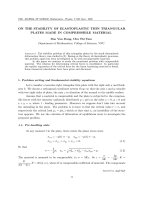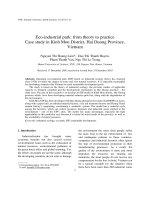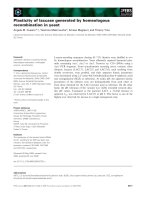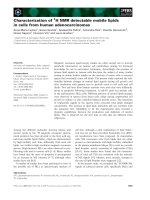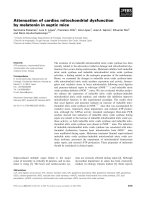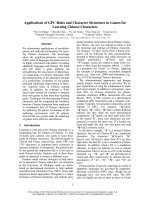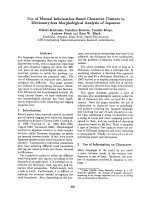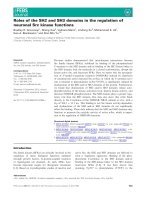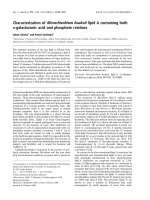BÁO CÁO " ACCESS TO CREDIT OF ANIMAL PRODUCTION HOUSEHOLDS: A STUDY IN HAI DUONG PROVINCE, VIETNAM " potx
Bạn đang xem bản rút gọn của tài liệu. Xem và tải ngay bản đầy đủ của tài liệu tại đây (183.03 KB, 11 trang )
J. Sci. & Devel., Vol. 10, No. 7: 1050-1060
Tạp chí Khoa học và Phát triển 2012. Tập 10, số 7: 1050-1060
www.hua.edu.vn
1050
ACCESS TO CREDIT OF ANIMAL PRODUCTION HOUSEHOLDS:
A STUDY IN HAI DUONG PROVINCE, VIETNAM
Le Thi Minh Chau
1*
, Philippe Lebailly
2
, Nguyen Tuan Son
3
1
Faculty of Accounting and Business Management - HUA;
2
Gembloux Ago-Bio Tech, University of Liege, Belgium;
3
Faculty of Economics and Rural Development - HUA
Email*:
Received date: 06.11.2012 Accepted date: 17.12.2012
ABSTRACT
Recently, the credit supply from the formal credit sector to the rural area has increased considerably. However,
the credit supply to agriculture is still far from the actual credit need and mismatching with the economic and social
contribution of agriculture sector to the rural area. Using data from the household survey in Hai Duong, finding of this
paper shows that the credit supply from the formal sector did not meet the credit need of animal production
households. In the borrower’s side, dependency ratio, area of crop land, area of fish pond and number of pigs were
main factors influencing their credit accessibility from the formal sector. In addition, age, educational level of
household head and size of fish pond were key factors affecting the loan amount approved by the banks. The
weaknesses in the rural credit supply from the formal sector also resulted in some constraints of animal producer’s
credit accessibility.
Keywords: Access to credit, animal production, rural credit, Vietnam.
Tiếp cận tín dụng của các hộ chăn nuôi:
Nghiên cứu tại tỉnh Hải Dương, Việt Nam
TÓM TẮT
Trong những năm gần đây,cung cấp tín dụng cho nông thôn từ khu vực chính thức đã tăng trưởng đáng kể. Tuy
nhiên đầu tư tín dụng cho nông nghiệp còn chưa đáp ứng được nhu cầu về tín dụng cho sản xuất và chưa tương
xứng với đóng góp của nông nghiệp cho sự phát triển kinh tế và xã hội trong khu vực nông thôn. Nghiên cứu này sử
dụng số liệu điều tra từ hộ chăn nuôi ở Hải Dương và kết quả của nghiên cứu chỉ ra rằng tín dụng cung cấp từ khu
vực chính thức vẫn chưa đáp ứng được nhu cầu về tín dụng của các hộ chăn nuôi. Tỷ lệ người phụ thuộc, diện tích
đất trồng trọt, diện tích ao, số lượng lợn thịt là các yếu tố liên quan đến nhu cầu vay của hộ về tín dụng từ khu vực
chính thức. Ngoài ra, tuổi, trình độ học vấn của chủ hộ, diện tích ao cá là yếu tố cơ bản ảnh hưởng đến khả năng
tiếp cận tín dụng của hộ từ các ngân hàng được phản ánh bằng số tiền vay nhận được. Những hạn chế trong cung
cấp tín dụng nông thôn của khu vực chính thức cũng gây trở ngại cho tiếp cận tín dụng của người chăn nuôi.
Từ khóa: Chăn nuôi, tín dụng nông thôn, tiếp cận tín dụng, Việt Nam.
1. INTRODUCTION
In the period 2001-2010, the annual growth
rate of credit supply
1
from Vietnam Bank for
Agricultural and Rural Development (VBARD),
1
Inflation rates in Vietnam were 8.5% in 2005, 22.1% in
2008 and 9.2% in 2010 (GSO, 2010).
Vietnam Bank for Social Policies (VBSP),
People Credit Funds (PCFs) and micro financial
institutions was 21.0%, 34.5%, 22.6% and 45%,
respectively
2
. The growth of credit supply was
resulted by the implementation of credit policies
2
Collected from the annual reports of VBARD, VBSP, PCFs
and Microfinance intuitions.
Le Thi Minh Chau, Philippe Lebailly, Nguyen Tuan Son
1051
in responding to agricultural and rural
development. The formal sector, including
VBARD, VBSP and PCFs was the main credit
source in the rural area (Lan and An, 2005;
World Bank, 2007). Moreover, in the period
2003-2007, the Government invested 113
thousand million VND in agriculture, roughly
estimated to meet only 17% of the actual needed
capital for this sector (Phong, 2010; Hung,
2012). The agriculture has played a crucial role
in economic and social development of Vietnam.
Presently, 60% of labour still engages in
agriculture (GSO, 2010). Many Vietnamese
experts stated that the Government’s
investment in the rural areas and credit supply
to agriculture have been inappropriate. The
relatively large gap between the economic
contribution of agriculture to Vietnam’s GDP
and credit provision to agriculture exists (Anh,
2010; Ha, 2010; Phong, 2010).
Animal production is predominantly
operated in small-scale household production
units. At present, in the market the majority of
meat is supplied by small producers. About 80%
of poor households in Vietnam raise animals and
about 30% of total agricultural income of
households comes from animal production (Lapar
et al., 2003). With its important role, in the
strategy for animal production for the period
2010-2020 the Government of Vietnam stated
that the improvement in small-scale of animal
production is necessary to create stable income
for farmers (DLHV, 2010). Given the limited
financial capital of the poor and small producers,
they cannot adopt new production technologies
that demand higher investment and higher cost
production (Lapar et al., 2006). The access to
credit could reduce the constrained financial
capital of farm households and provide the
working capital for farmers to purchase
production input and apply modern technologies
as well. In Vietnam, credit is generally shown to
have a significant impact on agricultural
production of farmers (Duong and Izumida,
2002). It was suggested that an improvement in
credit access of animal producer could facilitate
the animal production. This paper aimed to
examine the current access to credit from various
credit sources, identify the factors affecting credit
accessibility of animal production
3
households
and finally draw some policy implications for a
better credit access of animal production
households from the formal sector.
2. RESEARCH METHODS
- Selection of the study site and data
collection: Selection of the study site and
sample households for primary data collection
were done step by step. Hai Duong, located in
the Red River Delta region, is selected as the
study site due to some following reasons.
Firstly, agriculture occupied 64.2% of total
labour in 2010. Job creation in agricultural
sector is required for their income generation.
Secondly, the agricultural land area has been
significantly reduced owing to the industrialized
process, 7.6% in the period 2006-2010 (HDSO,
2010). Thirdly, Hai Duong has the potential for
animal production because it is located near
Hanoi capital, where the demand for meat and
fish of consumers has increased steadily.
Hai Duong, Cam Giang, Chi Linh, Kim
Thanh and Tu Ky districts, where 70-80% of
total labour work in the agricultural sector,
were selected as representative districts. Then
in each district, one representative commune
was randomly drawn. Finally, 145 animal
production households, who operated in the
small-scale and belonged to low and medium
income households, were randomly selected for
data collection by using a semi-structured
questionnaire.
- Group discussion: It was organized to
investigate the strengths and weaknesses of
credits supply from formal credit sources based
on farmers’ assessment.
- Data analysis: SPSS software was used
for data processing using descriptive statistics
and analysis of variance (ANOVA). F- test was
used for mean comparison.
3
Animal production refers to poultry, breeding and fattening
pig, and fish production.
Access to credit of animal production households: A study in Hai Duong province, Vietnam
1052
3. RESEARCH RESULTS
3.1. General profile of surveyed hous
eholds
The surveyed households engaged in
integrated animal production consist of poultry,
breeding and fattening pig, and fish and differ
in terms of scale. The proportion of annual
income from animal production to total income
was selected as a criterion to classify surveyed
households into two groups, namely the animal-
based group and the non animal-based group.
The purpose of this classification was to explore
some differences in credit accessibility between
two groups.
As illustrated in Table 1, the age of
household head, family size and the number of
workers showed small differences between two
groups. The household heads in the animal-
based group have slightly higher educational
level than those in the non animal-based group.
Generally, the farmers with low level of
education likely have more limited access to
economic and social information than the others
with high level of education. The area of crop
land was of similar size for both groups and
relatively small due to high population in Hai
Duong. With limited land area for crop
cultivation, the expansion and improvement in
animal production are important for farmers. It
could partly contribute to an increase in
household income. The animal-based group
owned relatively large area of fish pond and
higher value of assets than the non animal-
based group.
3.2. Participation of households in the
rural credit market
As detected from the survey, there was a
high demand for credit from both groups. The
animal-based group needs credit to buy feed,
upgrade fish ponds and payback old loans. The
farm households in the non animal-based
group, who were unskilled workers, did not find
stable off-farm jobs and earned low income from
those activities. Therefore, they desired to
borrow money for their animal production. The
farmers borrowed money from the formal sector
or the informal sector. It was also possible for
them to borrow from both sources at the same
time. 77.2 % of borrowers in the animal-based
group obtained credit from the formal sector,
while this figure in the non animal-based group
was 51.4 % (Table 2). With respect to each
formal credit source, the proportion of
borrowers in the non animal-based group that
obtained credit from VBSP (52.5%) was higher
than that of the animal-based group (20.8%).
It was found that many borrowers in the
non animal-based group were the poor - target
clients of VBSP- so they borrowed money easily
Table 1. Information on surveyed households
Indicator Unit
Animal-based group (n=58) Non animal-based group (n=87)
Mean S.D Mean S.D
Age of household head Years old 45 7.5 46 9.3
Education of household head School years 7.5 1.3 7.0 1.1
Family size Persons 4.6 1.0 4.5 0.9
Number of workers Persons 2.4 0.8 2.5 0.8
Dependency ratio 0.4 0.1 0.5 0.2
Area of crop land 1000 m
2
2.2 0.9 2.6 1.1
Area of fish pond 1000 m
2
9.8 6.7 4.0 3.6
Fish pond Household 57 27
Total value of assets Mill. VND 127 84 85 62
Source: Household survey, 2011.
Le Thi Minh Chau, Philippe Lebailly, Nguyen Tuan Son
1053
from this source. 60.4% of borrowers in the
animal-based group got loan from VBARD,
while this figure in the non animal-based group
was 32.5%. This tendency was also similar for
PCFs. Two main reasons led to this situation
are: (i) VBARD and PCFs are commercial
banks. The lending interest rates of both banks
are determined by the same level of other
commercial banks but higher than that of VBSP
and (ii) Physical collateral is required for a
borrower. However, the non animal-based
group, including many of the poor, often lacks
the physical collateral. As a result, they had
less access to credit of VBARD and PCFs.
With regard to the informal sector, both groups
borrowed money from this sector. The non
animal-based group depended on the informal
credit more than the animal-based group. This
implies that the credit provided by the formal
sector did not fulfil the credit need of farm
households. Of the total number of surveyed
households, 41 households did not get any credit
in 2010, even they had credit need. Some
farmers indicated that their families were
ranked as the non-poor households in the
village. Thus, they were excluded from the
VBSP’s beneficiaries. Some others also reported
that they did not get any loan from VBSP due to
limited fund of the bank for lending. The
remaining farmers did not borrow money from
VBARD and PCFs owing to various reasons
which are referred to in later section. On
average, the number of borrowers from VBARD
was the highest. The average amount of loan
provided by VBARD was also the highest among
the credit sources. The number of borrowers of
PCFs was lower than those of VBARD and
VBSP but loan amount of PCFs was ranked the
second among the three formal lenders. VBSP
provided small loans.
For all credit sources, the average loan
amount of the animal-based group was
considerably higher than that of the non animal-
based group. Furthermore, the number of
borrowers from the formal sector in the animal-
based group was also higher than that in the non
animal-based group. This partly reflects a higher
demand for credit and a better credit
accessibility of the animal-based group compared
to the other group as both groups need loans to
finance for their production and consumption.
Table 2. Financing sources of surveyed households in 2010
Indicator
Total Animal-based group Non animal-based group
No. % No. % No. %
I. Surveyed households 145 58 87
II. Borrowers
1. Formal sector 81 62.8 44 77.2 37 51.4
- VBARD 45 48.4 32 60.4 13 32.5
- VBSP 32 34.4 11 20.8 21 52.5
- PCFs 16 17.2 10 18.8 6 15.0
2. Informal sector 48 37.2 13 22.8 35 48.6
- Friends and relatives 33 67.3 7 53.8 26 72.2
-Village moneylender 16 32.7 6 46.2 10 27.8
3. Both sectors 25 11 14
III. Household without loan 41 12 29
Source: Household survey, 2011.
Note: Total number of borrowers of the formal sector is lower than the total number borrowers from all lenders (VBARD,
VBSP, PCFs) because one household can borrow money from different lenders in the same year. It is similar for the total
number of borrowers from the informal sector.
Access to credit of animal production households: A study in Hai Duong province, Vietnam
1054
Table 3. Loan amount by credit sources in 2010
(Unit: Million VND/per household)
41
Total Animal-based group Non animal-based group
F value
Mean Range Mean Range Mean Range
I. Formal sector
52
1. VBARD 28.2 5.0-50 31.9 15-50 18.8 5-30 16.6
***
2. VBSP 8.4 4-17.2 8.5 4-17.2 8.3 4.3-8.6 0.01
3. PCFs 25.3 10-35 25.5 20-35 24.5 10-30 0.1
II. Informal sector
6
1. Friend and relatives 5.6 1-20 10.2 2-20 4.3 1-13 13
***
2. Village money lender 10 2.5-25 14.6 10-20 7.3 2.5-25 4.7
*
Source: Household survey, 2011.
Note: ***, **, * significant at 1%, 5% and 10% level, respectively.
3.3. Factors affecting borrowing amounts of households from the formal and informal sector
Table 4. Characteristics of household borrowers from the formal sector
(grouped by range of loan amount)
7 3
Indicator Unit
Range (million VND)
F- ratio
Up to 10
n=20
11-20
n=18
21-30
n=27
31-50
n=16
Age of household head Years old 48.2
(7.6)
46.8
(9.1)
48.5
(6.6)
45.0
(7.1)
0.84
Education of household head School year 6.8
(1.1)
7.3
(1.2)
7.2
(1.1)
7.5
(1.2)
1.6
Family size Persons 4.7
(0.9)
4.5
(0.6)
4.8
(1.3)
4.3
(0.6)
0.75
Number of workers Persons 2.3
(1.0)
2.5
(0.7)
2.6
(1.0)
2.4
(1.6)
0.47
Dependency ratio 0.53
(0.2)
0.45
(0.1)
0.41
(0.2)
0.43
(0.1)
1.3
**
Area of crop land 1000 m
2
2.1
(0.6)
3.0
(1.2)
2.3
(1.3)
2.8
(1.1)
2.4
*
Area of fish pond 1000 m
2
1.2
(0.8)
3.1
(1.9)
3.5
(2.9)
4.2
(2.3)
2.3
*
Number of poultry head 185
(60)
198
(95)
200
(101)
242
(18)
1.2
Number of pigs head 10
(7.8)
15
(12)
17
(9.6)
25
b
(14)
4.2
***
Source: Household survey, 2011.
Note: ***, **, * significant at 1%, 5% and 10 % level, respectively.
Values in parentheses are standard deviation.
4
In 2010, on average 19100 VND = 1 USD.
5,6
In 2010, lending interest rates per month were: VBARD: 1.16-1.3%; PCFs: 1.25-1.5%; VBSP: 0.5-0.8%; informal
moneylenders: 3%, estimated; and friend & relatives: 0%, normally. Loan terms were 2 years for VBARD, 1 year for PCFs and
2-3 years for VBSP
7
For this analysis, in order to obtain a good statistical result of mean comparison, borrowers did not separated into the animal-
based group and the non animal-based group due to the small number of borrowers
Le Thi Minh Chau, Philippe Lebailly, Nguyen Tuan Son
1055
In the transaction of credit, there are many
factors that simultaneously determine the
terms of contracts such as the amount, the
interest rate, the purpose, the collateral and the
repayment schedule. These are determined by
agreement between borrower and lender in the
rural market. It was observed that the loan
amount received from a credit source is based
on both credit demand and credit supply. The
implication is that the demand and supply
curves of credit cannot be identified separately
(Duong and Izumida, 2002). Based on the loan
amount, borrowers were classified into several
groups to compare some differences in
borrower’s characteristic and its relation with
their borrowing amounts (Table 4 and 5).
With respect to borrowing from the formal
sector, it was found that the household heads
obtaining higher level of education had a better
skill of production and they also had better
understanding of lending procedure of formal
credit sources. Therefore, they wish to borrow a
large amount of money for the expansion of
production. Findings from the survey show that
there were some small differences in family size
and the number of workers among surveyed
households. However, the dependency ratios of
the households were quite different. The
households having higher dependency ratios
borrowed lower amounts of money from formal
sources than households having lower
dependency ratios. It can be explained that they
usually need credit for their urgent
consumption while in the rural area of Vietnam
the formal sector mainly provide credit for
production and business. The households owned
big fish ponds, higher number of poultry and
pigs had higher demand of credit for purchasing
of production inputs. They prefer to borrow
money from formal credit sources because
interest rates were quite lower than those of
village money lenders. It was found that
farmers did not use their loans from formal
sources for crop production. Instead, they used
their own money to invest in crop production,
thus short of money for animal production. For
this reason, households having larger area of
crop land likely borrowed a large amount of
money from the formal sector. In the demand
side, the positive factors affecting borrowing
amount from the formal sector were the
educational level of household head, dependency
ratio, area of crop land, area of fish pond, and
number of poultry and pigs. The result of F-test
showed that dependency ratio, area of crop
land, area of fish pond and number of pigs were
statistically significant. It means that they were
dominant affecting factors.
Table 5. Characteristics of household borrowers from the informal sector
(grouped by range of loan amount)
Indicator Unit
Range (million VND)
F- ratio Up to 10 (n=38) 11-25 (n=10)
Mean SD Mean SD
Age of household head Years old 46.0 9.6 47.0 6.5 0.07
Education of household head School year 7.1 1.0 6.9 1.2 0.15
Family size Persons 4.5 0.8 4.9 0.8 1.6
Number of workers Persons 2.4 0.8 2.6 0.9 0.25
Number of dependants Persons 2.0 0.6 2.2 0.4 0.9
Dependency ratio 0.46 0.1 0.45 0.1 0.02
Area of crop land 1000 m
2
2.3 0.9 2.0 0.7 0.45
Area of fish pond 1000 m
2
2.2 1.4 5.3 4.5 4.8
*
Amount of informal loan Mill. VND 15.1 10.3 25 10.8 5.0
**
Number of poultry Head 173 58 226 89 5.0
**
Number of pigs Head 10.6 7.3 23.9 15.5 9.9
***
Source: Household survey, 2011.
Note: ***, **, * significant at 1%, 5% and 10 % level, respectively.
Access to credit of animal production households: A study in Hai Duong province, Vietnam
1056
With regard to borrowing from the informal
sector, it was likely that old household heads
had a better social relationship with their
relatives and village moneylender. As a result,
they borrowed larger amounts of money from
the informal sources than the young household
heads did. The educational level of the
household heads had a negative relation with a
borrowing amount from the informal sector
because many of farmers who obtained high
education normally tried to obtain credit from
the formal sector. In addition, the households
with large family size, high number of workers,
high number of dependants, a large area of fish
pond, and high number of poultry and pigs
borrowed a high amount of money from the
informal sector because they need credit not
only for animal production but also for their
family expenditure (e.g. tuition fee, medical fee,
funeral expenditure and repayment of old loan).
The informal sector is able to lend for such
borrowing purposes due to flexibility and
monitoring advantage of this sector. It is
important to note that households who obtained
large amounts of loan from the formal sector
also borrowed large amounts of money from the
informal sector. This phenomenon existed
because many households borrowed money from
moneylender to payback their old debt for the
formal sources at a due date.
In the borrowers’ side, the age of household
heads, area of fish pond, number of poultry and
pigs, and amount of loan from the formal sector
positively affected borrowing amount from the
informal sector while educational level of
household heads negatively related to
borrowing amount from the informal sector. The
result of F-test showed that area of fish pond,
number of pigs, and amount of loan from the
formal sector were statistically significant. It
implies that they were key factors influencing
borrowing amount from the informal sector.
3.4. The formal sector’s behaviours in
responding to credit demand of households
Of total surveyed households, the poor
household accounted for about one third. Loan
from VBSP with subsidized interest rate was
targeted to the poor. The fund of VBSP for lending
is limited. Most of the non-poor realized that they
were excluded from VBSP’s beneficiaries.
Consequently, they did not propose to borrow
money from this source. On the other hand, the
lending method of VBSP differs from those of
VBARD and PCFs. VBSP uses the group lending
method while VBARD and PCFs provide loan on
the requirement of physical collateral. For these
reasons, this paper only focused on analysing the
behaviour of VBARD and PCFs as commercial
banks responding to credit demand of farm
households.
Table 6. Indicators reflecting participation of households
and responses of VBARD and PCFs to their credit demand
Total Animal-based group Non animal-based group
No. % No. % No. %
1. Credit demanded household 145 58 87
2. Non credit-applied household 69 11 58
3. Credit-applied household 76 100 47 100 29 100
3.1. Approved loan application
- A full required loan amount 41 53.0 26 55.3 15 51.7
- A part of required loan amount 20 27.0 16 34.0 4 13.8
3.2. Refused to approve a loan 15 20.0 5 10.7 10 34.5
Source: Household survey, 2011.
Le Thi Minh Chau, Philippe Lebailly, Nguyen Tuan Son
1057
Both VBARD and PCFs are formal lenders
and provide credit on collateral. In order to
obtain credit from banks, households have to
submit their loan application form to the banks.
Of 145 surveyed households, 76 households
applied for credit to VBARD or PCFs whereas
69 remaining households had demand for credit
but they did not apply. The reasons leading to
this situation were that they were afraid of not
being able to repay their loans, afraid of being
refused, lack of collateral and high interest rate.
Among the households having applied for loans,
34 % of credit applied households in the animal-
based group was provided a part of required
loan amount, which was relatively higher than
13.8 % of credit applied households in the non-
animal based group. It is necessary to note that
the proportion of credit applied households, who
were refused to provide loan, were 10.7% for the
animal based group and 34.5% for the non
animal-based group. For those who were not
provided with loans, staff of the banks
responded that it was due to unavailability of
lending funds at the time they applied for
borrowing money. The farmers also stated that
annually in the last four months they were in
needs of credit to invest in animal production.
However, it is more difficult for them to obtain
loan from banks.
VBARD and PCFs are lending on physical
collateral
1
8
. Currently, the land use certificate
2
9
is considered as the unique physical collateral
accepted by VBARD and PCFs. Generally, the
farm households who hold large land area and
have the land use certificate have a better credit
accessibility. Housing, production equipments
8
VBARD does not require physical collateral for loan
amount less than 10 million VND (based on Decision
67/1999/QD-TTg, credit policy for agriculture and rural
development, dated May 30
th
,1999 ).
9
In 1993, the government of Vietnam promulgated the land
law with issuance of land use certificate for farmers and the
introduction to a new law. Although land still remains the
property of the state, under the new law usage rights could
legally be transferred, sold, leased, bequeathed and used as
collateral for loans. The duration of tenure rights was
extended to 20 years for agricultural land and to 50 years for
forest land.
and livestock are not accepted as physical
collateral. However, they also partly influenced
lending decision of bank’s staff, because staff of
VBARD and PCFs visit the farmers’ houses and
take a look on their assets to estimate their
asset value before deciding to provide loan. The
farm households who possess high value of
assets and high number of livestock may have a
better capability of loan repayment. Therefore,
they are likely to have a better credit
accessibility. VBARD and PCFs provided the
households with a fully required loan amount.
The households who proposed a medium loan
amount had a large land area, high value of
assets and high number of poultry and pigs.
Despite owning land use certificates, the
households applying for higher amounts but
having smaller land area, lower value of asset
and lower number of pigs and poultry were
provided lower loans as required or even
refused to provide loan. It seems that the higher
demand for loan amount of borrowers resulted
to the more constraints from the banks.
In the rural area of Vietnam, the
information on credit supply usually comes from
the staff of mass organizations and PCFs in
communes and is very important for borrowers
to obtain a loan. It was found that the older
household heads had a better credit
accessibility than the younger because the older
household heads had wider and stronger
relationships with the communal staff than the
young ones. As a result, they had a better
ability to gather credit-relevant information. It
implies that social relationships also affected
credit accessibility of farmers. Furthermore,
younger household heads with higher level of
education and lower non-farm household
income wish to borrow higher amounts of money
for the expansion of livestock production.
However, they were provided only partial
amount of the requested loan. On the contrary,
the household heads with older age and lower
level of education had lower demand for credit
but they were approved full required loan
amounts. It was also found that in response to
the strong demand for credit of young farmers,
Access to credit of animal production households: A study in Hai Duong province, Vietnam
1058
Table 7. Indicators reflecting the influence of household’s characteristics
on lending decision of VBARD & PCFs
Indicator Unit
Approved a full
required loan amount
(n=41)
Approved a part of
required loan amount or
Refused to provide a loan
(n=35)
F-value
Mean S.D Mean S.D
Amount of required loan Mill. VND 24.5 9.8 58.5 21.5 71
***
Amount of approved loan Mill. VND 24.5 9.8 33.5 7.9 12
***
Age of household head Years old 48.2 7.7 44.5 7.8 4.1
**
Education of household head School year 7.2 1.2 7.8 1.3 5.1
**
Family size Persons 4.5 0.7 4.8 1.3 1.2
Dependency ratio 0.42 0.14 0.45 0.13 0.8
Area of crop land 1000 m
2
2.7 1.2 2.6 1.2 0.04
Area of fish pond 1000 m
2
39.3 2.5 30.6 2.2 1.9
*
Total value of assets Mill. VND 132.1 96.6 120.7 73.7 0.3
Number of poultry Head 226 101 195 87 1.9
Number of pigs Head 20.9 14.3 17.7 9.3 1.0
Non-farm income Mill. VND 24.3 16.7 22.6 13.3 0.2
Source: Household survey, 2011.
Note: ***, **, * significant at 1%, 5% and 10 % level, respectively.
the formal sector limited their desired amount
of loan. In summary, age, educational level,
social relationship of household heads, land
area, and number of pigs and poultry were
factors influencing the lending decisions of
VBARD and PCFs. The result of F-test showed
that age, educational level and area of fish pond
were key affecting factors.
3.5. Strengths and weaknesses of the formal
sector in Hai Duong - An assessment of
animal production households
Lack of access to credit and access
constraints of farmers were not only determined
by human, physical capital and social
characteristics of animal production households
but also influenced by weaknesses of rural
Table 8. Strengths and weaknesses of the formal sector’s performance in Hai Duong
Strengths
Providing credit with the lower interest rate than the village moneylender.
Offering longer term of loan than the informal sector.
Applying more simple lending procedures than before.
Weaknesses
VBSP: (i) Limited fund for lending; (ii) High dependence on approval of the village head and the staff of local mass organization
for loan obtaining; (iii) Irregularity of loan disbursement; (iv)Uniform loan amount.
VBARD: (i) Higher interest rate than VBSP; (ii) Shortage of lending fund in the rural area, particularly in the last months of years;
(iii) Providing limited information on lending procedure and credit programs; (iv) Less interested in rural lending than urban
lending.
PCFs: (i) Less attention to credit provision for agriculture (including animal production) than non- agricultural business; (ii) High
interest rate than VBARD and VBSP; (iii) Short loan term.
Constraints to credit accessibility of animal production households
(i) Farmers lack information about lending program without requirement of physical collateral from VBARD; (ii) Many farmers
hesitated to borrow money for animal production from VBARD and PCFs due to lacks of physical collateral, high interest rate and
lacks of information on lending; (iii) Time of credit disbursement and amount of approved loan did not meet the credit demand of
the borrower.
Source: Farmer group discussion, 2011.
Le Thi Minh Chau, Philippe Lebailly, Nguyen Tuan Son
1059
lending of the formal sector the later is
considered as an external affecting factor to
credit accessibility of farmers. Assessment of
farmers about the strengths and weaknesses of
the formal sector in Hai Duong was carried out
by group discussion (Table 8). The advantages
or strengths of the formal sector have created
opportunities for loan receiving of animal
producers in the recent years. Besides, the
weaknesses of this sector also lead to
constraints for credit access of farm households.
4. CONCLUSION REMARKS
In Hai Duong, the credit supply of the
formal sector did not meet the credit need of
animal producers. Farm households still depend
on credit from the informal sector. The animal-
based group need more loan for their production
than the other group. They borrowed larger
amounts of money from the formal credit sector
than the non-animal based group. The non
animal-based group need credit, but they
depend on the informal lenders. Credit
accessibility of the animal production
households affected by both demand side and
supply side. With respect to demand side, area
of crop land, fish pond and number of pigs were
the major positive factors and dependency ratio
was a negative factor affecting borrowing
amount from the formal sector. It also found
that area of fish pond, number of pigs, and
amount of formal sector loan were dominant
factors positively influencing on borrowing
amount from the informal sector.
VBSP mainly provides credit for education
expenditure. Therefore, credits provided by
VBARD and PCFs were of crucial importance
for animal production. The age, educational
level of household head and area of fish pond
were the main factors positively affecting loan
amounts that were approved by VBARD and
PCFs. The age of household head likely implied
the social relationship of household. It could
conclude that the social relationship also
positively influenced the credit accessibility of
farmers. The additional finding is the stronger
credit needs of farmers were more rationed by
VBARD and PCFs. The study indicates that a
large demand for credit exists in Hai Duong but
weaknesses in rural lending of the formal sector
resulted in some constraints of credit access by
animal producers.
For borrowers’ side, the findings suggest
that it is necessary to improve education level
and social relationship of farmers to enhance
their credit accessibility to the formal sector. In
addition, the formal sector should improve the
credit supply that enables animal production
households to have a better access to credit.
Some policy implications for the formal sector
consist of (i) For VBARD, information on credit
program without collateral requirement should
effectively inform to farmers. The lending
network between VBARD and mass
organizations should be strengthened. In the
next years, it is important for VBARD to
implement the Decree No.41/2010/ND-CP
effectively (dated on August 12, 2010, which
allows VBARD to provide non-collateral loan
with a maximum of 50 million VND to farm
households); (ii) With transaction offices located
in commune, PCFs should have more competitive
strategies to increase their outreach to the rural
borrowers; (iii) Both VBARD and PCFs should
enhance the ability of saving mobilization to
have sufficient lending funds in order to meet the
strong credit need of animal producers; (iv) For
VBSP, the credit supply for agricultural
production should also be increased.
REFERENCES
Anh, Nguyen Kim. (2010). The Development of Rural
Finance Market in Rural Area of Vietnam. Paper
Presented at the Conference on "The Development
of Rural Finance in Vietnam Effectively", 8-9
Novemember, 2010. Ha noi, Vietnam.
DLHV (Department of Livestock Husbandry of
Vietnam) (2010). Annual Report 2010 and the
Strategy for the Coming Years based on the
Decision 10/2008/QD/TTg on “Approval of the
Strategy for Livestock Production up to the Year
2020, Promulgated by the Prime Minister of
Vietnam dated on 16/10/2008”.
Duong, Pham Bao and Izumida Yoichi (2002). Rural
Development Finance in Vietnam: A
Microeconometric Analysis of Household Surveys.
World Development 30: 319-335.
Access to credit of animal production households: A study in Hai Duong province, Vietnam
1060
GSO (General Statistical Office) (2010). Statistical
Year Book. Statistical Publishing House. Hanoi,
Vietnam.
Ha, Nguyen Thu (2010). Current situation of Rural
financial Market in Vietnam and Solutions for
Development. Paper Presented at the Conference
on "The Development of Rural Finance in Vietnam
Effectively", 8-9 Novemember, 2010. Ha noi,
Vietnam.
HDSO (Hai Duong Statistical Office) (2010). Hai
Duong Statistical Year Book. Statistical Publishing
House. Hanoi, Vietnam.
Hung, Ho. (2012). Nông dân vẫn khát vốn.
Doawnloaded 3/ 2012 from http://www.
baomoi.com/Home/TaiChinh/www.thesaigontimes
.vn/Nong-thon-van-khat-von/5412701.epi.
Lan, Le and Tran Nhu An (2005). Towards a Viable
Microfinance Sector in Viet Nam: Issues and
Challenges. nternational Labour Organization in
Vietnam. Working Paper. No.5.
Lapar, Ma Lucila A., Vu Trong Binh and Simeon Ehui
(2003). Indentifying Barriers to Entry to Livestock
Input and Output Markets in Southeast Asia.
Livestock Sector Report. Livestock Information,
Sector Analysis and Policy Branch. Food and
Agriculture Orgnization.
Lapar, Ma Lucila A., Vu Trong Binh, Nguyen Tuan Son,
Marites Tiongco, Mohammad Jabbar and Steve Staal
(2006). The Role of Collective Action in Overcoming
Barriers to Market Access by Smallholder Producers:
Some empirical Evidence from Northern Vietnam.
Paper Presented at the Workshop on "Collective
Action and Market Access for Smallholders". 2-5
October, Cali, Colombia.
Phong, Nguyen Minh (2010). The Development of Rural
Credit Marker in Rural Area- Experience from China
and Current Situation in Vietnam. Paper Presented at
the Conference on "The Development of Rural
Finance in Vietnam Effectively", 8-9 Novemember,
2010. Ha noi, Vietnam.
World Bank (2007). Vietnam - Developing a
Comprehensive Strategy to Expand Access for the
Poor to Microfinance Services- Promoting
Outreach, Efficiency and Sustainability. Volume 1:
The Microfinance andscape in Vietnam.
Washington, DC, The World Bank. Downloaded
12/2010, from
intvietnam/Resources.

